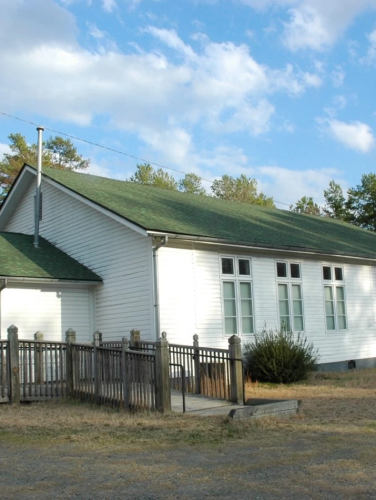
Huntersville Rosenwald School #2
(ca. 1925)
One of Mecklenburg County’s six surviving Rosenwald schools, Huntersville School #2 educated generations of African American children while symbolizing local resistance to segregation.
508 Dellwood Drive, Huntersville, NC 28078
As the result of early twentieth-century Jim Crow laws and segregationist policies, African American children across the United States suffered vast disparities in educational opportunities. Segregated public schools for African American students were often inferior to and lacked the services and facilities of schools for White children, creating roadblocks for social mobility and equal opportunity. In response, Sears-Roebuck president Julius Rosenwald and Tuskegee Institute founder Dr. Booker T. Washington formed a collaborative effort to improve public elementary education for rural African American students. From the 1910s to the 1930s, the Julius Rosenwald Fund operated as a unique and successful private/public partnership, combating educational inequalities by aiding in the construction of approximately 5,400 public schools for African American children. Over 800 Rosenwald schools were constructed in North Carolina, including twenty-six in Mecklenburg County. Huntersville School #2, one of the county’s six remaining Rosenwald schools, continues to be a cherished social and community center for local Pottstown residents.
Property Quick Links
Affectionately known as “the Little School” by former students and neighbors, Huntersville School #2 opened in 1925 to replace a smaller 1921 Rosenwald school once located on the present site of Huntersville’s New Friendship Presbyterian Church on North Old Statesville Road. The four-room Huntersville School #2 was constructed to accommodate four teachers. It sat on a 3-acre parcel of land donated by Olin W. Hunter, for whom the town of Huntersville was named. Local African American residents helped fund the $5,100 total construction cost for the new schoolhouse, consistent with Rosenwald Fund policies. Attended by the youth of Pottstown and the surrounding neighborhoods, the school quickly became an integral part of the region’s African American community. Like other Rosenwald Schools, the Little School served both as a symbol of resistance to segregation and a grassroots effort to challenge Jim Crow laws and white supremacy.
A second public school for African American students opened nearby in 1937. The Huntersville Colored School (later renamed Torrence-Lytle School) initially served grades 1 through 11. The following year, Huntersville School #2 was combined with the new school into a single union school, with the former Rosenwald school building serving grades 1 through 4 and the newer school building housing grades 5 through high school. Because Huntersville School #2 lacked many resources available at the new building, students often traveled to the larger facility for such amenities as the library and cafeteria. The combined school also shared an administration staff headed by principal Isaac T. Graham. After the closure of Huntersville School #2 in 1958, Graham continued as the principal of the Torrence-Lytle School until its closing in 1966.
Residents of Pottstown, the predominantly African American community that provided most of the Huntersville School #2 student population and still surrounds the building, refused to let the institution languish following the 1958 closure. They formed the Huntersville Better Community Civic Organization to purchase the building and convert it into a community center. For more than 96 years, the building (alternatively known as the Dellwood Center and the Torrence Lytle Community Center) has been a gathering center and focal point for the African American community in north Mecklenburg County.

